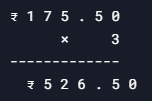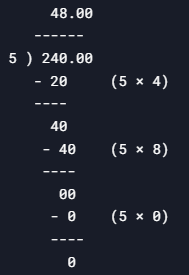Everyday Mathematics: Time and Money | Mathematics Olympiad Class 4 PDF Download
Q1. A pencil costs ₹ 5.50, and a notebook costs ₹ 12.75. How much will you pay for 2 pencils and 1 notebook?
(a) ₹ 23.75
(b) ₹ 18.25
(c) ₹ 20.50
(d) ₹ 25.00
Ans: (a) ₹ 23.75
Cost of 2 pencils = 5.50 × 2 = ₹ 11.00.
Cost of 1 notebook = ₹ 12.75.Total = 11.00 + 12.75 = ₹ 23.75.
Q2. A movie starts at 3:15 p.m. and ends at 5:45 p.m. How long is the movie?
(a) 2 hours 15 minutes
(b) 2 hours 30 minutes
(c) 3 hours
(d) 1 hour 45 minutes
Ans: (b) 2 hours 30 minutes
From 3:15 p.m. to 5:15 p.m. is 2 hours. Then, 5:15 p.m. to 5:45 p.m. is 30 minutes. Total = 2 hours + 30 minutes = 2 hours 30 minutes.
Q3. A pack of chocolates costs ₹ 15.75. How much will 4 packs cost?
(a) ₹ 60.00
(b) ₹ 62.50
(c) ₹ 63.00
(d) ₹ 65.25
Ans: (c) ₹ 63.00
Total cost = 15.75 × 4 = ₹ 63.00 (15.75 × 4 = 63.00, place decimal after two digits from the right).
Q4. A school bus leaves at 7:45 a.m. and takes 1 hour 25 minutes to reach school. What time does it arrive?
(a) 9:00 a.m.
(b) 9:10 a.m.
(c) 8:50 a.m.
(d) 8:55 a.m.
Ans: (b) 9:10 a.m.
Start time = 7:45 a.m.
Add 1 hour = 8:45 a.m.
Then add 25 minutes: 45 + 25 = 70 minutes = 1 hour 10 minutes.
So, 8:45 a.m. + 1 hour 10 minutes = 9:10 a.m.
Q5. A school day starts at 8:00 a.m. and ends at 2:30 p.m. How many hours and minutes does it last?
(a) 6 hours 30 minutes
(b) 7 hours
(c) 6 hours
(d) 5 hours 30 minutes
Ans: (a) 6 hours 30 minutes
From 8:00 a.m. to 2:00 p.m. = 6 hours.
Then, 2:00 p.m. to 2:30 p.m. = 30 minutes.
Total = 6 hours 30 minutes.
Q6. A movie ticket costs ₹ 175.50, and 3 friends buy tickets. How much money do they pay in total?
(a) ₹ 525.50
(b) ₹ 526.50
(c) ₹ 527.50
(d) ₹ 528.00
Ans: (b) ₹ 526.50
Total cost = 175.50 × 3 = ₹ 526.50.
Q7. A bag of rice costs ₹ 240.00. If it is divided equally among 5 families, how much does each family pay?
(a) ₹ 48.00
(b) ₹ 50.00
(c) ₹ 46.50
(d) ₹ 45.75
Ans: (a) ₹ 48.00
Cost per family = 240.00 ÷ 5 = ₹ 48.00
Q8. Ravi takes 150 seconds to finish his homework page. How many minutes and seconds is this?
(a) 2 minutes 30 seconds
(b) 2 minutes 50 seconds
(c) 3 minutes
(d) 1 minute 50 seconds
Ans: (a) 2 minutes 30 seconds
We Know that,
Divide 150 by 60: 150 ÷ 60 = 2 minutes (120 seconds) + 30 seconds left. So, 150 seconds = 2 minutes 30 seconds.
Q9. A shop sells juice for ₹ 12.50 per bottle. If 6 bottles are sold, how much money does the shop earn?
(a) ₹ 75.00
(b) ₹ 72.50
(c) ₹ 70.00
(d) ₹ 77.50
Ans: (a) ₹ 75.00
Total earnings = 12.50 × 6 = ₹ 75.00
Q10. Priya’s dance class lasts 1 hour 45 minutes. If it starts at 15:30 hours, when does it end?
(a) 17:15 hours
(b) 16:45 hours
(c) 17:00 hours
(d) 16:15 hours
Ans: (a) 17:15 hours
1530 hours = 3:30 p.m.
Add 1 hour = 4:30 p.m. (16:30 hours).
Add 45 minutes: 4:30 p.m. + 45 minutes = 5:15 p.m. = 17:15 hours.
|
32 videos|98 docs|48 tests
|
FAQs on Everyday Mathematics: Time and Money - Mathematics Olympiad Class 4
| 1. What is the importance of learning about time and money in Class 4? |  |
| 2. How can students practice telling time in a fun way? |  |
| 3. What are some simple ways to teach children about money management? |  |
| 4. Why is it necessary to understand both hours and minutes when learning about time? |  |
| 5. What role do word problems play in learning time and money concepts? |  |



















